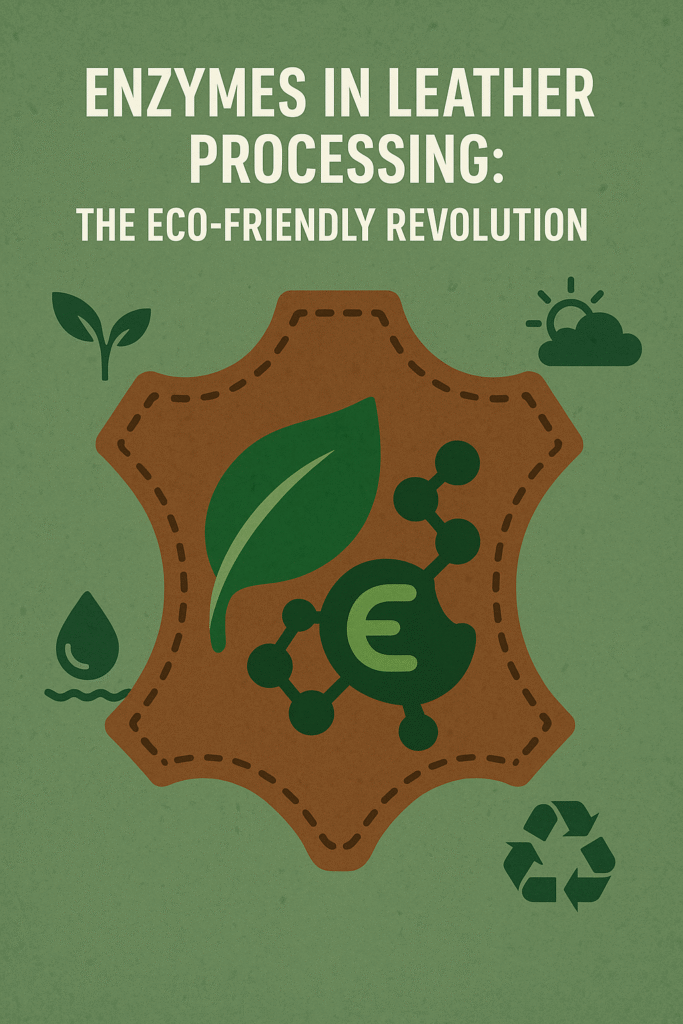
Enzymes in Leather Processing: The Eco-Friendly Revolution
The leather industry is undergoing a transformative shift with the increasing adoption of biotechnology, particularly through enzyme-based processes. Unlike traditional methods that rely on harsh chemicals, enzymes offer a sustainable and efficient alternative, enhancing leather quality while reducing environmental impact.
From soaking and unhairing to degreasing and waste management, enzymes play a crucial role in every stage of leather production. This blog explores how biocatalysts are revolutionizing leather processing, making it cleaner, more efficient, and eco-friendly.
The Role of Enzymes in Leather Processing:
Leather production involves multiple stages, each requiring precision to ensure high-quality output. Enzymes optimize these processes by:
✔ Reducing chemical usage
✔ Improving leather softness and uniformity
✔ Lowering energy consumption
✔ Minimizing wastewater pollution
Let’s explore how enzymes enhance each stage of leather manufacturing.
1. Soaking: Preparing Raw Hides
The first step in leather processing involves rehydrating dried hides to remove dirt, blood, and salt.
Enzymes Used:
Amylases (break down carbohydrates)
Proteases (dissolve proteins)
Lipases (remove fats)
Benefits:
✔ Faster rehydration
✔ Improved fiber structure
✔ Cleaner, more uniform hides
2. Unhairing: Removing Hair & Epidermis
Traditional unhairing uses lime and sulfides, which are highly polluting. Enzymes offer a greener alternative.
Enzyme Used:
Alkaline Proteases (target hair roots without damaging collagen)
Benefits:
✔ Eco-friendly (reduces sulfide pollution)
✔ Softer leather with higher yield
✔ No fiber damage
3. Fiber Opening: Enhancing Softness & Absorption
This step ensures the leather remains flexible and absorbent for tanning.
Enzyme Used:
Carbohydrases (open fiber structure for better water penetration)
Benefits:
✔ Reduces water consumption
✔ Enhances tanning efficiency
✔ Lowers wastewater treatment costs
4. Bating: Refining Leather Texture
Bating removes unwanted proteins, making leather softer and more pliable.
Enzyme Used:
Proteases (break down elastin, albumin, and keratin residues)
Benefits:
✔ Smoother grain texture
✔ Improved dye absorption
✔ No collagen damage
5. Degreasing: Removing Excess Fats
Natural fats in hides can affect dyeing and finishing. Enzymes ensure uniform color and texture.
Enzyme Used:
Lipases (break down oils and greases)
Benefits:
✔ Cleaner, more consistent leather
✔ Eco-friendly alternative to solvents
✔ No fiber weakening
6. Waste Processing: Sustainable Byproduct Management
Leather processing generates significant waste, but enzymes help biodegrade solid residues.
How Enzymes Help:
✔ Hydrolyze protein-rich waste at 55°C (optimal enzyme activity)
✔ Reduce sludge formation
✔ Lower environmental pollution
Key Benefits of Using Enzymes in Leather Production:
✅ Eco-Friendly – Reduces toxic chemical discharge
✅ Energy Efficient – Works at lower temperatures
✅ Cost-Effective – Lowers water and chemical usage
✅ Superior Quality – Produces softer, more durable leather
✅ Waste Reduction – Biodegradable processing minimizes pollutio
Popular Leather Processing Enzymes:
1. Leathozyme-PROAL (Protease for Soaking)
Function: Rehydrates hides by breaking down connective proteins
Benefits: Removes flesh and fat without damaging collagen
2. Leathozyme-PRO (Alkaline Protease for Unhairing)
Function: Penetrates hair roots for easy removal
Benefits: Produces smooth, wrinkle-free leather
3. Leathozyme-LP (Lipase for Degreasing)
Function: Eliminates grease and oils
Benefits: Ensures uniform dye absorption
4. Texozyme-TP (Protease for Bating)
Function: Removes unwanted proteins (elastin, albumin)
Benefits: Enhances leather softness and dye uptake
The Future of Enzymes in Leather Manufacturing:
As sustainability becomes a priority, enzyme technology is set to dominate the leather industry. Future advancements include:
🔹 Custom-engineered enzymes for specific leather types
🔹 Zero-waste processing with complete biodegradability
🔹 AI-optimized enzyme blends for maximum efficiency
Conclusion:
Enzymes are transforming leather processing into a cleaner, greener, and more efficient industry. By replacing harsh chemicals with biocatalysts, manufacturers can produce high-quality leather while minimizing environmental harm.
The shift toward enzyme-based leather production is not just a trend—it’s the future of sustainable fashion and manufacturing.